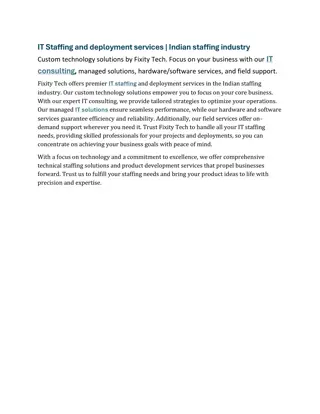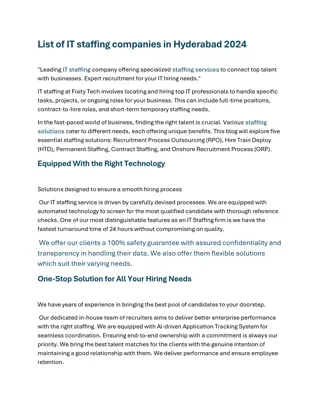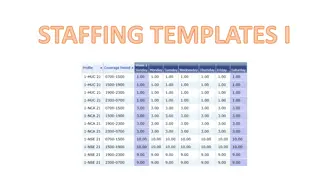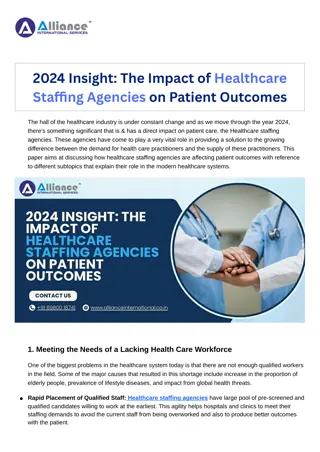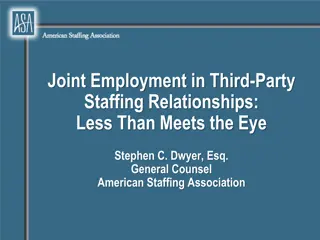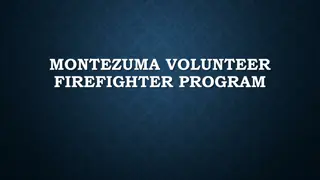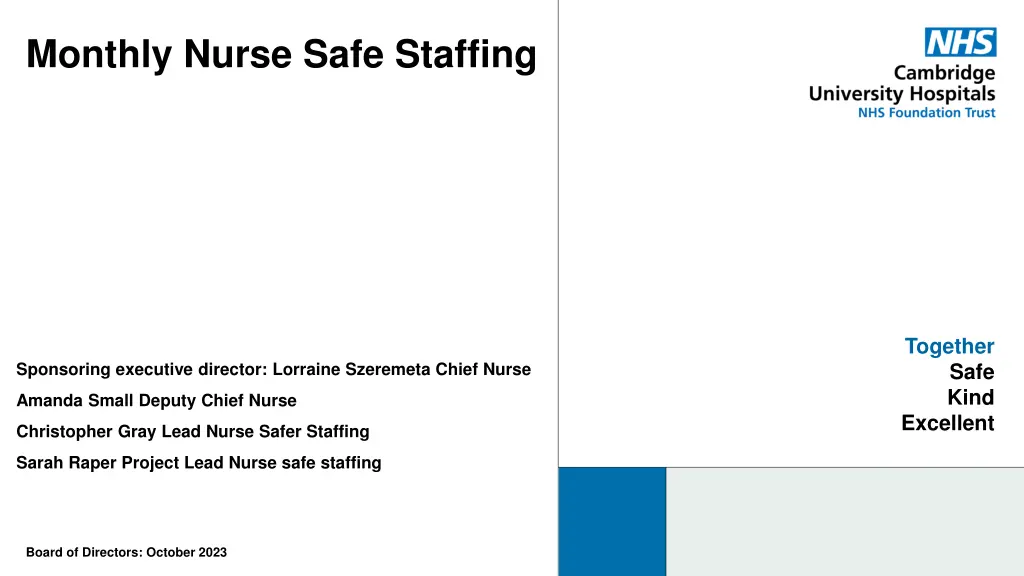
Nursing and Midwifery Staffing Overview August 2023
Get insights into the nursing and midwifery staffing position for August 2023, including vacancy rates, turnover data, planned versus actual staffing, and measures taken to mitigate staffing risks.
Download Presentation

Please find below an Image/Link to download the presentation.
The content on the website is provided AS IS for your information and personal use only. It may not be sold, licensed, or shared on other websites without obtaining consent from the author. If you encounter any issues during the download, it is possible that the publisher has removed the file from their server.
You are allowed to download the files provided on this website for personal or commercial use, subject to the condition that they are used lawfully. All files are the property of their respective owners.
The content on the website is provided AS IS for your information and personal use only. It may not be sold, licensed, or shared on other websites without obtaining consent from the author.
E N D
Presentation Transcript
Monthly Nurse Safe Staffing Together Safe Kind Excellent Sponsoring executive director: Lorraine Szeremeta Chief Nurse Amanda Small Deputy Chief Nurse Christopher Gray Lead Nurse Safer Staffing Sarah Raper Project Lead Nurse safe staffing Board of Directors: October 2023
Executive Summary This slide set provides an overview of the Nursing and Midwifery staffing position for August 2023. The vacancy position in August has increased in all areas due to the financial ledger being reflective of budgeted positions within the electronic staff record (ESR). For registered children's nurses (RSCN s) the vacancy rate is 23.1% (21.6% in July), Health Care Support Workers (HCSW) 17.1% (14% in July), maternity care assistants (MCA s) at 24% (23.1% in July), registered nurses (RN s) 10.9% (8% in July) and Registered Midwifes (RM s) 6.87% (0.33% in July). The turnover rate in August remains high but has decreased for RNs (11% from 11.3% in July), RSCNs (15.9% from 16.1% in July) and HCSW (including MCA s) (16.6% from 17.1% in July). However, for RMs turnover has increased to 13.1% (11.3% in July). The main reason for leaving for RN s, RM s, RSCN s and HCSW s is voluntary resignation relocation. The leavers destination data demonstrates that 27.4% of RNs and 44.1% of RMs are leaving to take up employment in other NHS organisations. 17.6% of RMs are leaving for no employment compared to 8.4% of RNs. Conversely, the leavers destination is unknown for the majority of HCSWs (47.5%). The planned versus actual staffing report demonstrates that 17 clinical areas reported <90% overall rota fill in August (15 in July). The overall fill rate for maternity has decreased to 88.9% compared to 92.8% in July. The total unavailability of the workforce working time in August has increased by 0.5% to 26.9%. The majority of unavailability (16.6%) is due to planned annual leave, sickness absence has decreased in August to 5.8% from 6.9% in July. Additionally, 1.1% of working time was unavailable due to other leave, 1.8% was due to study leave and 1.6% was due to supernumerary time. In order to mitigate staffing risks, the number of requests for bank workers remains high with an average of 2029.5 shifts per week requested for registered staff and 2046 shifts requested for Health care support workers and Maternity support workers per week with an average bank fill rate of 66.68% for registered staff and 62.73% for Health Care Support workers. In addition, the equivalent of 4.00WTE agency workers are working across the divisions (14.75 WTE July). Despite this, redeployment of nurses and midwives has remained necessary due to staff unavailability, with an average of 397 working hours being redeployed each day of which in August there has been a need to redeploy staff out of their division. The number of occasions that 1 critical care nurse has needed to care for more than 1 level 3 patient has increased in August to 160 occasions compared to 39 in July. It should be noted that this is not solely attributed to staffing rather that we have seen an increased level of acuity in critical care leading to a higher proportion of patients requiring level 3 care. Additionally, there have been 240 occasions in August where there has been no side room co-ordinator (160 in July). Any concerns with regards to critical care staffing are escalated through the senior nurse of the day. Staffing has been supported through the use of temporary workers (agency and bank) and registered staff (non critical care trained) are redeployed from the operational pool and clinical areas on a shift by shift basis. Critical care have opened 3 of the beds that were closed due to staffing resulting in 55 open beds rather than 59 beds. Recruitment is ongoing to the vacant positions with a plan to open the remaining 4 beds when vacancy allows. 2
Combined Nursing and Midwifery Staffing Position Vacancy Rates Graph 1. Nursing and midwifery vacancy rates Vacancy position The vacancy data for August is now reflective of the general ledger as the clinical division budgets have been loaded to ESR which has led to an increased vacancy position. The combined vacancy rate for Registered Nurses (RN s) and Registered Midwives (RM s) has increased to 10.9% in August from 8% in July. The vacancy rate for Health care support workers (HCSW s) (including Maternity Care Assistants (MCA s) has increased to 17.1% in August (14.0% July). When broken down further into Nursing and Midwifery specific vacancies, the MCA workforce vacancy rate has increased slightly to 24.0% from 23.1% in July. The HCSW vacancy rate (excl MCA) has seen an increase from 14% in July to 17.1% in August. Graph 2. Healthcare Assistant vacancy rates The HCSW (including MCA s) turnover rate remains high but has reduced slightly to 16.6% in August from 17.1% in July. The main reason for HCSWs leaving is voluntary resignation relocation (28.0%) and the next highest reason is voluntary resignation work life balance (27.5%). The leavers destination is unknown for the majority of HCSWs (47.5%), 15.0% of HCSW s are leaving to take up employment in other NHS organisations and 11.5% are leaving for no employment. 3
Staffing Position Vacancy Rates for Registered Nurses and Registered Midwives Graph 3. Registered Nurse vacancy rates Vacancy position The vacancy rate for Registered Nurses working in adult areas has increased to 10.9 in August (8% in July) as illustrated in Graph 3. The vacancy rate for registered children's nurses has also increased to 23.1% compared to 21.6% in July. The vacancy rate for Registered Midwives has seen a large increase, this is in the most part due to the financial ledger being aligned to ESR resulting in a vacancy rate for August of 6.87% compared to 0.33% in July. The turnover rate in August remains high at 11.0% for RNs in adult areas (11.3% in July), 15.9% for Registered children's nurses (16.1% in July) and 13.1% for RMs (11.3% in July). The main reasons for RMs leaving is voluntary resignation relocation (29.4%) and the next highest reason is voluntary resignation work life balance (26.5%). The main reason for RN s leaving is voluntary resignation relocation (43.3%). The leavers destination data demonstrates that 27.4% of RNs and 44.1% of RMs are leaving to take up employment in other NHS organisations. 17.6% of RMs are leaving for no employment compared with 8.4% of RNs. Graph 4. Registered Midwife vacancy rates 4
Unavailability for Registered Nurses, Midwives and Health Care Support Workers Graph 5. Unavailability of staff Unavailability of staff Unavailability relates to periods of time where an employee has been given leave from their regular duties. This might be due to circumstances such as annual leave, sick leave, study leave, carers leave etc. The total unavailability of the workforce working time in August 23 has increased slightly by 0.5% to 26.9% as illustrated in Graph 5. Graph 6 illustrates the percentage breakdown of the type of unavailability. The majority of unavailability (16.6%) was due to planned annual leave which would have been accounted for in the department rosters this is slightly above headroom at 16% but this can be attributed to bank holiday closure. There was a high percentage of unplanned leave that would have impacted upon fill rates within the rosters. In August, sickness absence has reduced to 5.8% in August from 6.9% in July. Other leave has remained relatively static at 1.1%, 1.8% was due to study leave and 1.6% was due to supernumerary time. Graph 6. Types of absence 1.10%Types of absence 5.80% 16.60% 1.60% 1.80% AL Study Supernumerary Sickness Other leave including Self Iso 5
Planned versus actual staffing Overall < 90% RN/RM < 90% HCSW < 90% Graph 7 Number of wards reporting < 90% rota fill Planned versus actual staffing Graph 7 illustrates trend data for all wards reporting < 90% rota fill. The number of areas reporting <90% rota fill for registered RN/RM has increased to 24 in August from 10 in July. The number of areas reporting <90% rota fill for HCSWs in August has remained high at 20. The number of ward areas reporting overall fill rates of <90% in August has increased to 17 compared to 15 in July. Appendix 1. details the exception reports for all areas reporting RN/RM fill rates of <90%. 30 25 20 15 10 5 The number of occasions that 1 critical care nurse has needed to care for more than 1 level 3 patient has increased in August to 160 occasions compared to 39 in July. It should be noted that this is not soley attributed to staffing rather that we have seen an increased level of acuity in critical care leading to a higher proportion of patients requiring level 3 care. Additionally, there have been 240 occasions in August where there has been no side room coordinator (160 in July). Any concerns with regards to critical care staffing are escalated through the senior nurse of the day. Staffing has been supported through the use of temporary workers (agency and bank) and registered staff (non critical care trained) are redeployed from the operational pool and clinical areas on a shift-by-shift basis. Critical care have opened 3 of the beds that were closed due to staffing resulting in 55 open beds rather than 59 beds. Recruitment is ongoing to the vacant positions with a plan to open the remaining 4 beds when vacancy allows. 0 Jul-22 Aug-22 Sep-22 Oct-22 Nov-22 Dec-22 Jan-23 Feb-23 Mar-23 Apr-23 May-23 Jun-23 Jul-23 Aug-23 RM Graph 8 Rosie Rota Fill % MSW Overall 105 100 95 90 % 85 80 Midwifery & MSW fill rate 75 70 Graph 8 illustrates that the overall fill rate for maternity has decreased slightly to 88.9% in August form 92.8% in July which is lower than the 12-month average of 90.08%. The lowest fill rates have been seen on Rosie Birth Centre (85%). Jul-22 Aug-22 Sep-22 Oct-22 Nov-22 Dec-22 Jan-23 Feb-23 Mar-23 Apr-23 May-23 Jun-23 Jul-23 Aug-23 6
Staff deployment Staff deployment Graph 9 illustrates the movement of staff across wards to support safe staffing to ensure patient safety. This includes staff who are moved on an ad hoc basis (shift by shift) and shows which division they are deployed to. The number of substantive staff redeployed has been an increasing trend over the last 3 months with 397 working hours being redeployed per day in August (362 hours in July). This equates to 35 long day or night shifts per day. 211 of these hours were redeployments made outside of staff members own division to support patient safety. Staffing is also being supported by the operational pool whereby bank staff book a bank shift on the understanding that they will work anywhere in the trust where support is required. However the fulfilment of these shifts has reduced significantly with the reduction in enhancements. Nursing Pipeline Appendix 2 provides detail on the forecasted position in relation to the number of adult RN vacancies based on FTE and includes UK experienced, UK newly qualified, apprenticeship route, EU and international up to March 2024. The current forecast demonstrates a year end band 5 RN vacancy position of 8.31% which is significantly above the target of 5%. This is due in part to the reliance on international recruitment and the increased national and international competition for such staff resulting in fewer deployments to CUH. The RN adult pipeline for 2023/24 now reflects the reduction in international recruitment. This is a national concern and has been escalated to NHS England. Work is being undertaken to explore RN Recruitment initiatives including increasing the International Recruitment pay band and reducing our shortlisting criteria. Appendix 3 provides detail on the forecasted position in relation to the number of Paediatric band 5 RN and HCSW vacancies up to March 2024. Numbers are based on those interviewed and offered positions in addition to planned campaigns. The current forecast demonstrates a year end band 5 Paediatric RN vacancy position of 20.71% and a band 2 HCSW position of 8.55%. Whilst the recruitment pipeline is positive with multiple pipelines including apprenticeship routes, domestic and international recruitment, the predicted numbers are only achievable if the appropriate infrastructure is in place to support. 7
Red flags Red Flags A staffing red flag event is a warning sign that something may be wrong with nursing or midwifery staffing. If a staffing red flag event occurs, the registered nurse or midwife in charge of the service should be notified and necessary action taken to resolve the situation. Nursing red flags Graph 10 illustrates that there has been a increase in the number of red flags reported with 286 reported in August. The highest number of red flags reported in August was in relation to an unmet 1:1 specialling requirement (138 compared with 92 in July). A trust wide improvement project focusing on specialling is being developed to review specialling across the organisation. All red flags have seen an increase except for more than 25% shortfall of RNs (17 in July compared to 12 in August). In, August 0 red flags were reported for less than 2 RN on shift. Maternity red flags The number of maternity red flags reported over the last 6 months has been a decreasing trend with 575 reported in September 22 compared to 203 in August 23. Graph 11 illustrates the red flags that have been reported. The highest number of red flags reported is for missed or delayed care 40.4%. 23.2% of red flags reported were due to a delay of >30mins between presentation and triage. This is a known area of concern as highlighted in the recent CQC report. 8
Safety and Risk Incidents reported relating to staff shortages Graph 12 illustrates the trend in Safety Learning Reports (SLRs) completed in relation to nurse staffing. In August there were 108 incidents reported compared to 54 in July. This is first time in 7 months the number of reported incidents has been above the mean. The majority of the incidents related to staffing levels in August were reported by division C (34) with the highest reporting area being J3 (7). However, the highest individual reporting area was JFICU (Critical care) in division A (9). Safety continues to be monitored through the site safety meetings. Care hours per patient day (CHPPD) Care hours per patient day (CHPPD) is the total number of hours worked on the roster (clinical staff including AHPs) divided by the bed state captured at 23.59 each day. NHS Improvement began collecting care hours per patient day formally in May 2016 as part of the Carter Programme. All Trusts are required to report this figure externally. Graph 13: Care Hours Per Patient Day (CHPPD) CUH CHPPD recorded for August increased to 9.35 from 8.62 in July. This is comparable to other Shelford hospitals (10.3). In maternity, from 1 April 2021, the total number of patients now includes babies in addition to transitional care areas and mothers who are registered as a patient. CHPPD for the delivery unit in August has increased to 16.11 (14.34 in July.) 9
Bank Fill Rate and Agency Usage Graph 14 Registered RN/RM Bank fill rate per week Bank fill rate The Trust s Staff Bank continues to support the clinical areas with achieving safe staffing levels. Graph 15 and 16 illustrate the trends in bank shift fill rate per week. Overall, we continued to see a decrease in August for bank shift requests for registered staff to mitigate those areas who have less than a rota fill of 90% or to cover an unmet specialling need. The number of requests for registered staff is an average of 2029.5 shifts per week with an average bank fill rate of 66.68% which is an increase from July 64.74%. The number of requests for Health care support workers and Maternity support workers remains high with an average of 2046 shifts per week with an average bank fill rate of 62.73% this is an increase from July 58.78%. Graph 15 HCSW/MSW bank fill rate per week In addition to bank workers we have the equivalent of 4.00WTE agency workers working (29.5 WTE in June, 14.75WTE in July) across the divisions to support staffing challenges in the short term. This agency usage is reducing and there is a focus to reduce further as the substantive position increases. Short term pay enhancements for bank shifts put in place earlier in the year to encourage a higher uptake of shifts have reduced in July with these now only being targeted to those areas with the highest vacancy. There has been a slight reduction in bank fill in correlation with this but not a significant decrease. This trend will continue to be monitored. Any bank enhancements in place are reviewed regularly (at least on a 6 weekly basis) through the weekly bank enhancement meeting and are for fixed periods of time. 10
Appendix 1. Exception report by Division Speciality Unit % fill registered % fill care staff Overall filled % CHPPD Analysis of gaps Impact on Quality / outcomes Actions in place Target CHPPD achieved, suggesting safe staffing May be within ratios for number of patients Otherwise; missed care, delay to medication, washes, discharges, poor patient satisfaction 110 - TRAUMA & ORTHOPAEDICS - PROTECTED Can be dependent on electives; if trauma levels high then elective may get cancelled which means elective ring fenced beds on D8 are not used- Surgical hub opening will focus on electives Raised at 08:15 and 4:15pm. Focus on redeploying staff if required. Division A 9.14 87% 118% 99% D8 Target CHPPD achieved, suggesting safe staffing GPIC Breaches. Potential delays to patient care and patient flow. Reduced supervisory time to mitigate may be considered. Reduction NQM and KPI's. Staff morale, retention of staff. Poor patient experience. Lack of ability to be preemptive due to clinical acuity. Raised at 08:15 and daily bronze, circulation of capacity and breaches list. Discharging wardables. PD and band 7s in numbers, requesting bank enhancements, managing sickness. Escalating at Ops meeting High acuity especially on NCCU, breaches, delayed wardables, non clinical transfers from NCCU to D3/D4, rise in sickness 192 - CRITICAL CARE MEDICINE - STANDARD Division A 24.54 86% 99% 89% D4 Target CHPPD achieved, suggesting safe staffing GPIC Breaches. Potential delays to patient care and patient flow. Reduced supervisory time to mitigate may be considered. Reduction NQM and KPI's. Staff morale, retention of staff. Poor patient experience. Lack of ability to be preemptive due to clinical acuity. Raised at 08:15 and daily bronze, circulation of capacity and breaches list. Discharging wardables. PD and band 7s in numbers, requesting bank enhancements, managing sickness. Escalating at Ops meeting High acuity especially on NCCU, breaches, delayed wardables, non clinical transfers from NCCU to D3/D4, rise in sickness 192 - CRITICAL CARE MEDICINE - RISK MANAGED JOHN FARMAN ICU Division A 28.09 82% 103% 86% Target CHPPD achieved, suggesting safe staffing GPIC Breaches. Potential delays to patient care and patient flow. Reduced supervisory time to mitigate may be considered. Reduction NQM and KPI's. Staff morale, retention of staff. Poor patient experience. Lack of ability to be preemptive due to clinical acuity Raised at 08:15 and daily bronze, circulation of capacity and breaches list. Discharging wardables. PD and band 7s in numbers, requesting bank enhancements, managing sickness. Escalating at Ops meeting High acuity especially on NCCU, breaches, delayed wardables, non clinical transfers from NCCU to D3/D4, rise in sickness 192 - CRITICAL CARE MEDICINE - RISK MANAGED Division A 30.18 86% 93% 88% NCCU 11
Appendix 1. Exception report by Division 75 unfilled RN shifts for August. 62 unfilled HCSW shifts for August. 1 red flag for unmet specialling 1:1. Supervisory SR time- 38.9%. 257 hours redeployed inbound. 16 incidents, no mod+ harm Highest category: Falls (4) One HAPU - SDTI No patients with more than 2 incidents Matron quality audit- bronze Hand hygiene, 97% Daily divisional mitigation; site safety escalation; weekly prospective staffing reporting and mitigation; divisional recruitment and retention strategy. Matron quality focus. Division C 361 - NEPHROLOGY - PROTECTED 7.42 86% 85% 86% C5 Target CHPPD achieved, suggesting safe staffing. 64 unfilled RN shifts for August. 100 Unfilled HCSW shifts for August. 2 red flags for unmet nursing skills. Supervisory SR time- 69.1%. 317 hours redeployed inbound. 19 incidents, no mod+ harm Highest category: Falls & Pressure ulcers (4) 2 of the pressure ulcers were HAPU s both SDTI s One patient with 3 incidents Matron quality audit- bronze Hand hygiene, 74% Daily divisional mitigation; site safety escalation; weekly prospective staffing reporting and mitigation; divisional recruitment and retention strategy. Matron quality focus. 300 - GENERAL MEDICINE - STANDARD Division C 7.30 90% 82% 87% EAU 4 58 unfilled RN shifts for August. 36 unfilled HCSW shifts for August. High unregistered annual leave %. 1 red flag for >25% shortfall in registered staffing. 2 red flags for omission of planned mobilisation and washes. 1 red flag for unmet specialling. 2 red flags for unmet nursing skills. Supervisory SR time- 49%. 307 hours redeployed inbound. 25 incidents, no mod+ harm Highest category: Moisture lesion (6) 2x HAPU both Cat 1 No patients with more than 1 incident Matron quality audit- bronze Hand hygiene, 96% Daily divisional mitigation; site safety escalation; weekly prospective staffing reporting and mitigation; divisional recruitment and retention strategy. Matron quality focus. 300 - GENERAL MEDICINE - RISK MANAGED Division C 6.59 87% 73% 82% N2 Risk mitigated via safe staffing meetings, staff from green area redeployment to areas that are high risk, ER adviser supporting Senior nurses in Sickness and Absence Management 300 - GENERAL MEDICINE - PROTECTED Division D 6.78 88% 93% 90% L5 Vascular inconsistent fill from bank and agency, increased nursing workload 12
Target CHPPD achieved, suggesting safe staffing. Current RN vacancy 7.65wte & HCA 4.18wte. 4.0wte HCA in pipeline in and 5.0wte RN in pipeline in Target CHPPD achieved, suggesting safe staffing. Current vacancies 4.0wte RN with 4.0wte in pipeline in. 29.52wte RN vacancy. 12.0 wte in pipeline in, 3.53wte in pipeline out no impact on NQM. Does impact on supervisory time for senior sister. regular quality & safety checks. WM supporting clinically. 171 - PAEDIATRIC SURGERY - STANDARD 11.66 89% 130% 97% D2 Division E no impact on NQM regular quality & safety checks. 171 - PAEDIATRIC SURGERY - PROTECTED 7.51 87% 90% 88% F3 COU Division E No impact on NQM Regular quality & safety checks. Unit leads supporting clinically Regular quality & safety checks 422 - NEONATOLOGY - RISK MANAGED 13.31 87% 37% 81% Division E Neonatal ICU Target CHPPD achieved, suggesting safe staffing. 18.29wte RN vacancy, 7.57wte HCA vacancy. 2.0wte HCA & 3.0wte RN in pipeline in. Target CHPPD achieved, suggesting safe staffing No impact on NQM 192 - CRITICAL CARE MEDICINE - RISK MANAGED 26.58 76% 96% 78% PICU Division E Staffing reviewed to ensure safe care, Staff moved within service to provide safe staffing. Staffing reviewed to ensure safe care, Staff moved within service to provide safe staffing. no impact on NQM, low patient numbers & acuity of patients. Staffing reviewed to ensure safe care, Staff moved within service to provide safe staffing. Staffing reviewed to ensure safe care, Staff moved within service to provide safe staffing. regular quality & safety checks. WM supporting clinically. Rosie Birth Centre 501 - OBSTETRICS - RISK MANAGED 15.57 83% 71% 80% Division E Skills mix with junior workforce, increased acuity. 501 - OBSTETRICS - RISK MANAGED 5.29 85% 86% 86% Sara Ward Division E Target CHPPD achieved, suggesting safe staffing. Current RN vacancy = 42.6% / 7.31wte. X2 B5 in pipeline & 1 B6 advertised. Charles Wolfson 424 - WELL BABIES - PROTECTED 13.65 87% 65% 80% Division E Target CHPPD achieved, suggesting safe staffing inconsistent fill from bank and agency, increased nursing workload Risk mitigated via safe staffing meetings, staff from green area redeployment to areas that are high risk, ER adviser supporting Senior nurses in Sickness and Absence Management Risk mitigated via safe staffing meetings, staff from green area redeployment to areas that are high risk, ER adviser supporting Senior nurses in Sickness and Absence Management 150 - Division D 10.28 87% 148% 113% A5 NEUROSURGERY - RISK MANAGED Target CHPPD achieved, suggesting safe staffing inconsistent fill from bank and agency, increased nursing workload 300 - GENERAL MEDICINE - PROTECTED Division D 7.33 87% 101% 93% G3 13
Appendix 2. Adult RN Recruitment pipeline Adult band 5 RN position based on predictions and established FTE Nursing Associates (60% of graduates) Anglia Ruskin NQ Promotions and transfer out of scope- retained by the trust Return to Practice UK based exp. Vacancy rate based on established FTE No. of vacancies based on established FTE applicants Other NQ ESR Starter leaver variance Overseas Total New Starters Staff in post FTE NAP Month Leavers FTE Establishm ent FTE 5 1 4 1 3 6 3 4 2 3 5 5 2 3 12 5 2 9 28 21 22 23 20 45 61 52 34 37 42 76 9 11 12 13 10 10 14 20 14 15 15 15 15 1534 1529 1531 1528 1753 1769 1795 1818 1822 1829 1841 1887 1699 1699 1699 1699 1931 1951 2020 2020 2059 2059 2059 2059 9.70% 10.00% 9.88% 10.06% 9.20% 9.31% 11.11% 9.97% 11.47% 11.13% 10.55% 8.31% 164.87 169.87 167.87 170.87 177.64 181.64 224.44 201.44 236.14 229.14 217.14 171.14 19 7 15 7 9 30 46 37 19 22 27 61 Apr-23 May-23 Jun-23 Jul-23 Aug-23 Sep-23 Oct-23 Nov-23 Dec-23 Jan-24 Feb-24 Mar-24 12 16 19 16 35 45 25 30 30 35 35 14 7 16 11 15 15 15 15 15 15 15 1 1 4 2 10 2 3 21 2 2 2 2 2 27 7 14
Appendix 3. Paediatric RN and Band 2 HCSW Recruitment pipeline Paediatric band 5 RN position based on predictions and established FTE Promotions and transfer out of scope- retained by the trust Anglia Ruskin NQ UK based exp. Leavers FTE (based on leavers in the last 12 months) Vacancy rate based on established FTE No. of vacancies based on established FTE applicants Other NQ Total New Starters FTE ESR Starter leaver variance Overseas Staff in post FTE NAP Month Establishm ent FTE 1 3 0 4 4 1 3 2 2 6 3 2 2 5 5 6 4 5 3 164.39 160.39 157.39 157.39 171.13 171.13 187.13 192.13 186.13 184.13 182.13 182.13 213.73 213.73 213.73 213.73 229.70 229.70 229.70 229.70 229.70 229.70 229.70 229.70 23.09% 24.96% 26.36% 26.36% 25.50% 25.50% 18.53% 16.36% 18.97% 19.84% 20.71% 20.71% 49.34 53.34 56.34 56.34 58.57 58.57 42.57 37.57 43.57 45.57 47.57 47.57 1 Apr-23 May-23 Jun-23 Jul-23 Aug-23 Sep-23 Oct-23 Nov-23 Dec-23 Jan-24 Feb-24 Mar-24 TOTAL 2 1 1 2 1 2 3 1 1 1 1 -2 -2 1 2 1 2 3 1 1 -0.53 1 2 1 1 1 2 2 1 Band 2 HCSW position based on predictions and established FTE 8 8 11 2 23 13 1 3 4 4 18 8 -5 -1 -1 1 Apprenticeship Vacancy rate based on established FTE 13.43% 12.64% 13.42% 14.32% 15.67% 15.16% 18.02% 15.67% 15.43% 13.13% 10.84% 8.55% 8.55% No. of vacancies based on established FTE (direct entry) UK based applicants Total New Starters FTE ESR Staff in post FTE Month Leavers FTE Establishm ent FTE 1 2 2 2 2 2 18 16 20 14 11 25 25 35 35 35 35 35 304 1 1 5 3 1 1 2 19 17 25 17 12 26 27 35 35 35 35 35 318 18 10 7 16 17 13 13 13 13 13 13 13 159 768 775 768 760 741 754 768 790 812 834 856 878 887 887 887 887 878 888 936 936 960 960 960 960 119 112 119 127 138 135 169 147 148 126 104 82 Apr-23 May-23 Jun-23 Jul-23 Aug-23 Sep-23 Oct-23 Nov-23 Dec-23 Jan-24 Feb-24 Mar-24 TOTAL 13 18 16 0 14 63 44.53 16 182.13 229.70 20.71% 47.57 1 14 877.57 959.6 82.03 15








